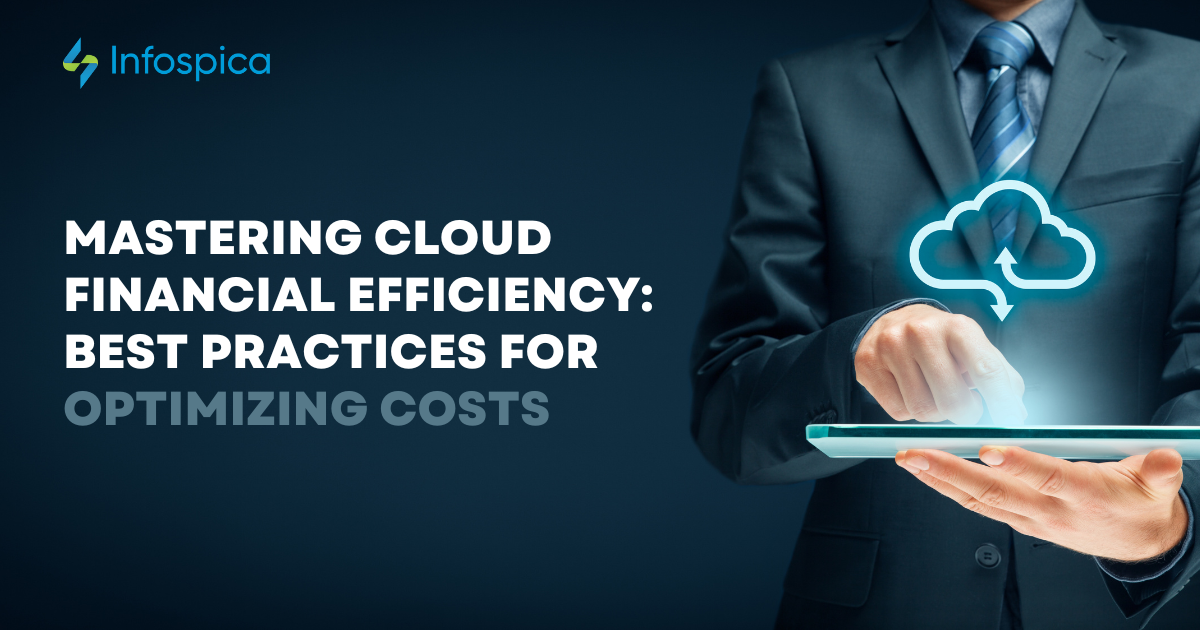Mastering Cloud Financial Efficiency: Best Practices for Optimizing Costs

In today’s rapidly evolving digital landscape, businesses are increasingly turning to cloud computing to enhance flexibility, scalability, and overall efficiency. As businesses increasingly rely on cloud computing to meet their computing needs, it becomes crucial to ensure that the costs incurred align with actual usage and deliver optimal value. Cloud cost optimization involves strategies and practices aimed at minimizing expenses while maintaining or enhancing performance, scalability, and flexibility.
In this article, we’ll delve into the world of cloud financial optimization, exploring best practices that can help your organization make the most out of its cloud investment.
Understanding key components that contribute to cloud expenses
Before we embark on our journey to optimize costs, Several key components contribute to cloud expenses, and understanding these elements is essential for effective cost management in cloud computing. Here are the primary components:
1. Compute Resources:
The cost associated with virtual machines or instances that run applications and process data in the cloud. It includes expenses for CPU, memory, and storage associated with these virtualized computing resources.
2. Data Transfer and Bandwidth:
Charges incurred when data is transferred in and out of the cloud environment. This can include data transfer between different regions, availability zones, or between the cloud provider’s services.
3. Storage:
Expenses related to storing data in the cloud. Cloud providers offer various storage options, each with its own pricing structure. Costs may vary based on factors such as storage class, redundancy options, and the amount of data stored.
4. Licensing and Software:
Costs associated with using specific software or licensing agreements within the cloud environment. Some cloud services include software licensing fees, and organizations may need to pay for additional licenses for certain applications.
5. Support Plans:
Charges related to service level agreements (SLAs) and premium support plans provided by the cloud service provider. Higher-tier support plans often come with additional costs but offer enhanced support and faster response times.
Best Practices for Cloud Financial Efficiency
Monitor and Analyze Spending:
Implement robust monitoring and analytics tools to track cloud spending. Set up budgets, alerts, and reports to gain insights into spending patterns. Regularly review and analyze this data to make informed decisions.
Monitoring spending helps identify trends, anomalies, and areas for potential optimization, allowing for proactive cost management.
Rightsizing of cloud resources:
Evaluate the performance and resource utilization of your virtual machines and other cloud resources. Adjust the size and configuration to match the actual needs of your applications. Avoid overprovisioning, as this leads to unnecessary costs. Rightsizing of resources ensures that you are paying for the resources you actually use, and optimizing costs.
Utilize reserved instances and savings plans:
Take advantage of Savings Plans offered by cloud providers. These models allow you to commit to a specific instance type and region for a one- or three-year term, providing significant cost savings compared to on-demand pricing. Savings Plans offer predictability and cost savings for stable, predictable workloads.
Implement auto-scaling:
Leverage auto-scaling features to automatically adjust the number of resources based on demand. This ensures that you have enough capacity during peak periods and scales down during off-peak times to avoid overpaying for idle resources. Auto-scaling improves resource utilization, maintaining optimal performance while minimizing costs.
Optimize Data Storage:
Regularly assess and categorize your data based on access patterns. Utilize appropriate storage classes (e.g., standard, infrequent access, archival) for different data types to optimize storage costs without compromising performance. Efficient data storage management ensures that you are not overspending on high-performance storage for data that is rarely accessed.
Implement Tagging Strategies:
Use tagging to label and categorize resources based on projects, departments, or environments. This allows for more granular cost allocation, making it easier to understand how resources contribute to overall spending. Tagging facilitates accurate cost attribution, helping organizations track and manage expenses across different teams and initiatives.
Explore Cloud Cost Management Tools:
Investigate third-party tools or native cloud management services that provide insights, recommendations, and dashboards for optimizing costs. These tools often offer a holistic view of your cloud spending and suggest specific actions for improvement. Cost management tools enhance visibility, making it easier to identify opportunities for optimization and implement changes efficiently.
Decide Between Single or Multi-Cloud Deployment
Multi-cloud setups provide flexibility to avoid vendor lock-in and improve availability, but they can be costlier. Opting for a single vendor enables you to benefit from discounts on bulk purchases. Yet, transitioning between diverse cloud platforms may pose challenges and demand extra training. Evaluate whether your organization’s needs are best met by a single-vendor or multi-cloud approach.
Leverage real-time analytics for prompt cost decision-making
Equipping team members with timely information empowers them to make well-informed decisions, ultimately impacting the bottom line and improving product quality. Identifying cost-saving opportunities early is crucial to avoid late realizations. By monitoring cost indicators and detecting any irregular patterns, you can ascertain whether your costs remain within standard ranges or if specific activities might lead to unnecessary expenditures.
Reduce Software License Expenditure
Software licensing constitutes a significant portion of overall cloud operating expenses. Managing licenses manually poses challenges and raises the likelihood of paying for unused software. Within the AWS Marketplace, numerous commercial and public Amazon Machine Instances are available. Implementing license tracking tools enables the identification of idle or unnecessary licenses, facilitating a reduction in overall spending.
Cloud cost optimization with Infospica
Optimizing cloud costs is a continuous effort that involves the entire organization, not just the IT department. It’s an ongoing process rather than a one-time activity. Regularly reviewing and evaluating your cloud expenses is crucial to guaranteeing the use of the most cost-effective solutions for your requirements. By incorporating the strategies outlined in this article, you can adeptly oversee your cloud costs, ensuring that your organization maximizes the benefits of its cloud investment.
Seek a personalized demonstration: a Cloud Advisor from Infospica will evaluate your existing cloud optimization strategy, offer additional success tips, and guide you through the features of our cloud cost management capabilities.